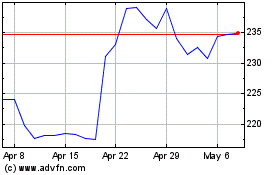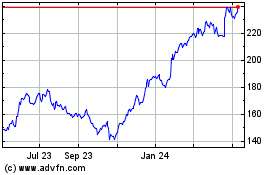New CEO will have to deal with increasing competition from
banks, fintech firms
By AnnaMaria Andriotis
This article is being republished as part of our daily
reproduction of WSJ.com articles that also appeared in the U.S.
print edition of The Wall Street Journal (October 21, 2017).
Entrepreneur Christopher Burch has been a loyal user of American
Express Co. cards since 1979. This year, he switched almost all his
spending to J.P. Morgan Chase & Co.'s Sapphire Reserve
card.
Regaining customers like Mr. Burch, who made the Forbes list of
wealthiest Americans in 2014, is one of the big challenges for
incoming AmEx Chairman and Chief Executive Stephen Squeri. Named
successor to longtime chief Kenneth Chenault on Wednesday, Mr.
Squeri takes over as the card giant stresses it is building
momentum after a recent rough stretch.
The reality is more complicated. AmEx is still dealing with
rising competition from banks and nimble fintech firms like PayPal
Holdings Inc., the Silicon Valley payments company whose market
value recently eclipsed AmEx's. Investors aren't clear, meanwhile,
on where long-term revenue growth will come from, or how AmEx will
deal with potential disruption to traditional payments channels
from new, mobile approaches.
When asked about competition at a shareholder lunch at Aretsky's
Patroon restaurant in Manhattan last year, Mr. Chenault put the
situation in a historical context, according to a person at the
meeting. But, Mr. Chenault added, the firm was under attack.
AmEx issues cards to consumers and businesses, both credit cards
and ones that must be paid off monthly. It runs its own card
network and also makes loans to people and companies.
The firm has spent recent years fending off rivals on several
fronts, which has worried some investors. Mr. Chenault's departure
is "good timing from a stock perspective but...there are still
challenges ahead," said Don Fandetti, a Wells Fargo & Co.
analyst.
Top of the to-do list for Mr. Squeri: regain the cachet of the
AmEx brand, both for millennials who don't view it the same way as
their parents and for established customers who have been wooed by
banks offering better services and more perks.
Mr. Burch, whose businesses include hospitality, technology and
retail investments, recalls that AmEx's concierge service in recent
years was unable to get him tables at several high-end NYC
restaurants; hotel upgrades became "bland."
Shortly after, employees of Mr. Burch suggested he try the
popular Sapphire Reserve card. He started using it.
In June, Mr. Burch emailed Mr. Chenault to share his
disappointment. A few weeks later, Mr. Burch said, he received an
email from a "customer relations representative of the executive
office" that read like a form letter.
As competitive pressures have mounted, AmEx has lost market
share to banks and to card networks such as Visa Inc. AmEx's market
share of total U.S. credit-card purchase volume fell to 22.9% last
year, according to Nomura Instinet, from 25.4% in 2015. It was
about 26% as recently as 2014.
The slip has in large part been the result of several co-branded
cards that AmEx has lost since 2015, including Costco Wholesale
Corp. and JetBlue Airways Corp.
Costco was viewed as a huge loss for AmEx by many shareholders,
but the company's earnings are starting to rebound from that. "It
turned out the decision on Costco was 100% the right decision,"
Warren Buffett, whose Berkshire Hathaway Inc. is the largest AmEx
shareholder, told the Journal in an interview. "Everybody thought
it was a mistake at the time, " but he said that since then, "the
progress is just terrific."
Mr. Chenault also defended his tenure, noting how he overcame
numerous challenges. "I've managed through three crises [including]
9/11 and the financial crisis," he said in an interview. "The
repositioning of what we did with co-brands was very
impressive."
Asked about the Sapphire Reserve card, Mr. Chenault said AmEx
has been "very focused on innovating" its Platinum card and that
the card is having "the best time ever."
To dig out of the company's slump and boost revenue, Mr.
Chenault leaned more on lending. That was a reversal from the years
after the financial crisis when he was wary of this business.
In the wake of the meltdown, Mr. Chenault opted to make the
company less bank-like and stay focused on revenue generated from
fees merchants pay it when customers use AmEx cards.
The company also put roughly $1 billion into a division that
focused mostly on the prepaid card market, according to a former
executive. But the effort failed to take off.
It wasn't until late 2014 when Mr. Chenault recognized the
disadvantage AmEx faced when competing with big lenders, according
to the person. Negotiations were underway for the Costco credit
card, and the deal appeared to be on the ropes.
Each time AmEx sweetened its bid, Costco told the company it
needed to do more. AmEx was ultimately outbid by an estimated $1
billion, the person said. Citigroup Inc. won the business.
The jolt changed Mr. Chenault's thinking on lending. At one 2015
meeting, he asked division heads how much revenue and profit they
could deliver in the next two to three years to fill the void left
by Costco. One executive said the firm could build U.S. loan
balances by 12%.
Mr. Chenault's response, according to a person familiar with the
meeting: "What would it take to make it even bigger?"
The company's lending push helped improve earnings this year,
but shareholders are becoming worried about future credit losses.
The firm's total provisions for losses jumped 53% in the third
quarter from a year prior. Competing in premium cards can be
costly, too; the company continued to increase expenses in the
third quarter.
"Their strategy has shifted to one that relies a bit more on
lending and it remains to be seen what the full effects of that
will be in the next downturn," said David Hochstim, a director and
senior research analyst at ClearBridge Investments, an AmEx
shareholder.
Write to AnnaMaria Andriotis at annamaria.andriotis@wsj.com
(END) Dow Jones Newswires
October 21, 2017 02:47 ET (06:47 GMT)
Copyright (c) 2017 Dow Jones & Company, Inc.
American Express (NYSE:AXP)
Historical Stock Chart
From Mar 2024 to Apr 2024

American Express (NYSE:AXP)
Historical Stock Chart
From Apr 2023 to Apr 2024
